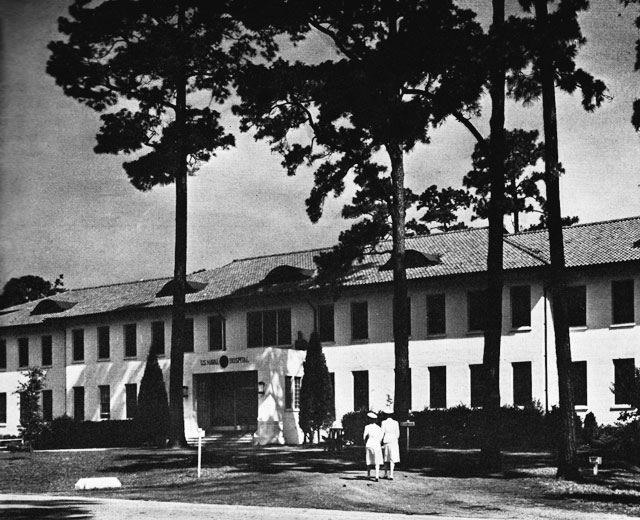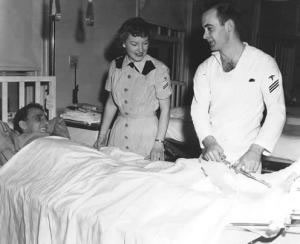
Naval Hospital Charleston in 1948. U.S. Navy photo.
By Don Campagna, special to Charleston Currents | Following the Spanish-American War, the United States found itself in need of a global navy that could serve its new, far-flung empire.

Campagna
In 1901, the decision was made to locate an East Coast base in Charleston and several Cooper River plantations, The Retreat and Marshlands, were purchased for that purpose. Work began almost immediately on the construction of a drydock and supporting trade shops. Additionally, a large coal-fired power steam plant in the Beaux Art style was built to provide electricity.
The new shipyard had barely been operational for a decade when the clouds of war dimmed the horizon and the nation was again embroiled in conflict. On the wooded land adjacent to the yard, Piney Grove Training Camp sprang up, a forest of tents occupied by 5,000 recruits being tutored in nautical skills. Unfortunately for them, the world was in the grips of a great flu pandemic. A crude dispensary ministered to those who fell prey, but many young men died and the seamen apprentices learned a hard lesson when it became their duty to dig the graves of their mates.
After the armistice in the Great War, America experienced prosperity and then a deep depression. The government established the Workers Progress Administration to provide meaningful employment and one of their tasks was to replace the antiquated medical facility with a state-of-the-art hospital. President Roosevelt, no doubt sensing a failed peace, thought the project so important that he came to inspect its progress twice.
 The main building was completed four months after the attack on Pearl Harbor. While the shipyard was busy turning out destroyers and landing craft, the new hospital fulfilled an equally important mission. Charleston became homeport to 18 Army-operated hospital ships and served as the point of debarkation for those most seriously wounded during the European and African campaigns. As many as 4,000 maimed, shellshocked and blinded casualties were received a month. Amid the blood drives by the staff and shipyard workers, even Helen Keller arrived on a morale-boosting visit.
The main building was completed four months after the attack on Pearl Harbor. While the shipyard was busy turning out destroyers and landing craft, the new hospital fulfilled an equally important mission. Charleston became homeport to 18 Army-operated hospital ships and served as the point of debarkation for those most seriously wounded during the European and African campaigns. As many as 4,000 maimed, shellshocked and blinded casualties were received a month. Amid the blood drives by the staff and shipyard workers, even Helen Keller arrived on a morale-boosting visit.
Peace merely changed the form of conflict into both a cold war and a hot one. The hospital not only treated the victims of Korea and Vietnam, but also served active-duty and retired personnel as well as their dependents. When the base was closed in 1996, the hospital was designated a National Historic District comprised of 32 buildings listed on the National Register. Today it stands as the only intact World War II military medical complex in the country.
Several years ago as part of a plan to transform the former naval base into a container facility, Palmetto Railways, a division of the S.C. Department of Commerce, submitted a request to the U.S. Army Corps of Engineers to construct a rail line that would bisect the Hospital District. The current proposed path would require the destruction of at least nine — and perhaps as many as 15 — of the listed buildings. At the same time to improve the grade for the trains, a trench that is the width of the right-of-way and as deep as 15 feet would be excavated. Separately, either of these actions would be sufficient to have the district stricken from the National Register.
Originally, Palmetto Railway proposed to make use of a dormant rail line that lies completely outside the district. The selection of that route would have spared the district and been compliant with laws and regulations of the National Transportation Act from whom the agency has requested funding. If Palmetto Railway were directed to enter into negotiations for a shared use agreement with CSX, owner of the out of service line, the Hospital District would be spared.
The threat to the site where the wounded warriors of the Greatest Generation were repaid by a thankful nation is so dire that The National Trust for Historic Preservation has placed it on its list of the Most Endangered Historic Places in America. South Carolina owes a debt to those who served and sacrificed as well as an obligation to future citizens to save The Charleston Naval Hospital Historic District.
- ACTION: If you’d like to send a message to save the Hospital District, you can sign an online petition to “Move the train” by clicking here.
Don Campagna, a U.S. Navy veteran, is the public information officer of the Naval Order of the United States. He lives in North Charleston. Have a comment? Send to: editor@charlestoncurrents.com



 We Can Do Better, South Carolina!
We Can Do Better, South Carolina!
























